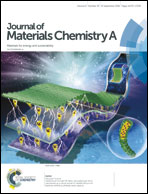Monitoring the assembly–disassembly–organisation–reassembly process of germanosilicate UTL through in situ pair distribution function analysis†
Abstract
A study into the disassembly and organisation steps of the ADOR process has been undertaken through in situ Pair Distribution Function (PDF) analysis. Three aqueous systems (water, 6 M HCl and 12 M HCl) were introduced to a parent zeolite germanosilicate UTL in a cell. Hydrolysis could be clearly seen when UTL was exposed to water over a period of 8 h, forming the disorder layered material, IPC-1P. In hydrochloric acid, the hydrolysis step is too quick to observe and a Ge–Cl containing species could be seen. In 6 M HCl, the rearrangement of the interlayer region began after an induction period of 8 h, with the process still occurring after 15 h. In 12 M HCl, the rearrangement appears to have come to an end after only 6 h.



 Please wait while we load your content...
Please wait while we load your content...